Buckler's Hard - the village
Buckler's Hard's two rows of red-brick terraced cottages, built at 90 degrees to the Beaulieu River, are familiar to all who have visited this attractive hamlet.
But what is perhaps not realised is that another row of houses once existed at the southern end, the top, of the main street, running at right angles to the existing rows of terraces, and to the south of the Maritime Museum. These cottages in what was known as Slab Row - the cottages were constructed of slabs of wood - provided squalid living conditions and were consequently demolished in the 19th century.
Similarly, another row of houses, known as Back Street, existed to the east of the east terrace. By 1918, only two dilapidated tenements remained - they were restored and extended in 1921, and enlarged and modernised in the 1970s.
Thankfully, the cottages and other buildings in the two main terraces survive to tell their tales of yester-year. Here are some of the more notable stories.
(1) The Master Builder's House
The Master Builder's House is arguably the best known property in Buckler's Hard, followed closely by the Maritime Museum.
Lying close to the river in the west terrace and now a popular hotel, bar and restaurant, the Master Builder's House dates back to the 1720s and the days of Montagu Town.
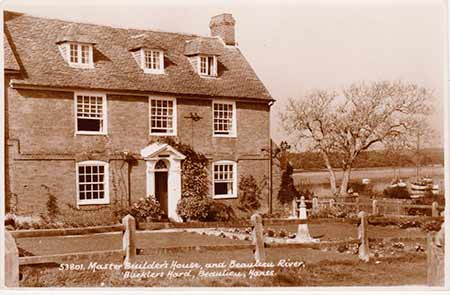
It was originally occupied by its builder, Alexander Morris, a Beaulieu builder who also managed the Beaulieu brickworks.
Shipbuilder John Darley was resident in 1747 and Henry Adams lived there from 1749 to 1805. Henry's son Edward Adams followed from 1813 to 1849 and his widow remained in occupation until 1852.
William Scanes, landlord of the New Inn until 1857, in that year moved to the Master Builder's House - he also had the lease of the shipyard from 1853 until 1872, albeit with a break in 1857.
It was known in the 19th century simply as the Shipbuilder's House and has been subject to a number of alterations and additions, but by 1910 it was said to be in a poor state of repair and became home to Jim Thomas, Lord Montagu's boatman, the harbourmaster.
It was then altered again and converted into a hotel in 1926, although initially without an alcohol licence. Other alterations and changes of ownership followed culminating in the current 'luxury' hotel known simply as the Master Builder's.
(2) St Mary's Chapel
Following the end of the shipbuilding industry, many of the red-brick cottages became homes for Beaulieu estate workers.
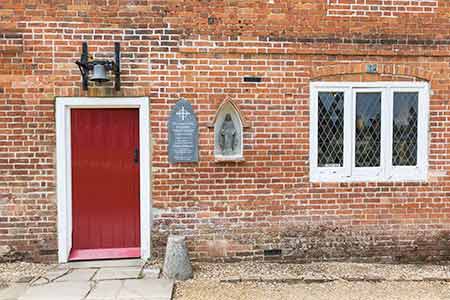
But number 82, with St Mary's Chapel on the ground floor, was to be more than simply a home. Located amidst the row of cottages on the western side of the street, St Mary's Chapel is of modest size with seating for a mere 40 people.
Originally a cottage occupied mainly by shipyard workers, it is thought that the building was also used by 18th century smugglers - what is said to be their hidden cellar was revealed by excavations and can now be glimpsed through a window next to the altar.
(The cottage is also said to have been a cobbler's shop, a trade risk-free and legal but no doubt far less profitable than smuggling).
In 1847 the cottage became the village infant school where religious services were occasionally held, whilst conversion to a full-time chapel came after closure of the school in the 1880s after Buckler's Hard parents voted with their feet and sent their children to Beaulieu where a higher standard of education was available.
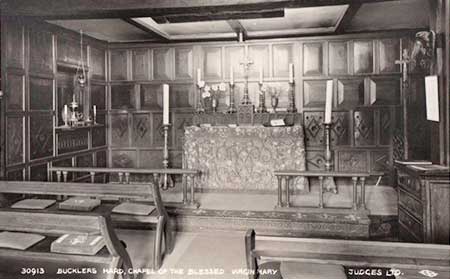
A plain altar was installed and the room dedicated in 1886 - the original altar was later replaced by one from a private chapel at Ditton Park, which was then also owned by Lord Montagu.
The chapel has seen many subsequent changes in its relatively short life including renovation during the 1914-18 war, and additions made after the war in memory of an airman killed in 1918. The bell came from an old church at Bonchurch, Isle of Wight, and the carved panelling from Lady Cross Lodge in the New Forest.
The statue of the Virgin Mary, of French origin, is more than 300 years old and stands on a Beaulieu Abbey chopping block, whilst a memorial cross recalls a 1933 drowning in the Beaulieu River.
Although still in use as a private chapel owned by the Montagu family, St Mary's is open to visitors throughout the year.
(3) Historic alehouses and village shops
The east terrace contained Buckler's Hard's two alehouses, places popular, no doubt, with the shipwrights, craftsmen, labourers, blacksmiths, farm workers and others employed locally, some of whom lived at in the village whilst others travelled in from outside, particularly during peak times of employment when vessel construction was underway.
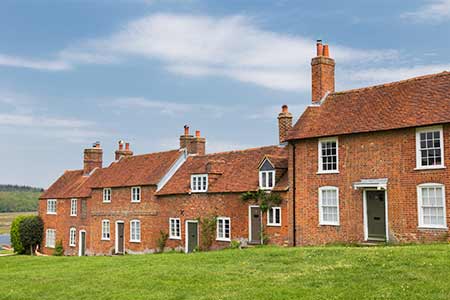
The Ship Inn, mid-way along the terrace at number 87, opened in 1752 and was later to become a tea shop serving cream teas, postcards and sweets to the 2,000, or so, day trippers who arrived annually on the Gosport Ferry.
(Such was the tea shop's popularity that it featured on early 20th century postcards. It subsequently became a private residence).
And at the top of the hill, at the terrace's southern end was the New Inn. This building dates from the second half of the 18th century. Maybe as early as 1774, James Wort opened a shop there which shortly after 1791 he combined with licensed premised to create the New Inn.
An inscription over the front door - Jos. Wort 1774 - suggests that the building may have been altered or extended at that time, although why Jos and not James remains a mystery. It was certainly altered in the 19th century and eventually housed the Maritime Museum, complete with a reconstruction of the inn's interior as originally it would have been.
Both inns acted as shops, community centres, places for board games and conversation, and collection points for the poor rate, subscriptions for friendly societies and much else. The New Inn is also said to have been a centre for smuggling.
Neither remains in business.
A.J. Holland noted that the dominance of alehouses came to an end during the last quarter of the 19th century following changes to licensing laws and the efforts of temperance societies, and went on to say that the First Lord Montagu, who acquired the estate from his father in 1867, enforced the closure of all but one of the nearby Beaulieu taverns.
And, of course, the demise of the shipyard and the consequent reduction in the local population did not help the businesses.
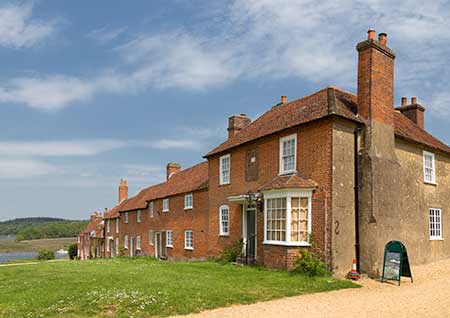
Again according to A.J. Holland, Benjamin Rawlings, aged 74, was the innkeeper at the Ship Inn in 1845 and D.T. Alston in 1849 (he combined the work with that of oyster agent), but by 1867 the premises were occupied by William Martin, fisherman and oyster agent.
The New Inn, meanwhile, was occupied by William Scanes in 1845 and 1849, but he was listed only as an inn and shopkeeper in 1845, and not in 1849. He apparently continued as landlord until 1857 when he moved to the Master Builder's House. By 1867, Frederick Shelley, shopkeeper and baker, occupied the premises.
Confusingly, however, Kelly's 1855 Post Office Directory lists William Scanes as the proprietor of the Ship Inn (and also as a baker and grocer) but makes no reference to the New Inn, nor are there further directory entries for either from at least 1878.
The most recent village shop at number 74, at the southern end of the west terrace, opened in the 20th century and was almost completely rebuilt in 1937 on former foundations. It had originally been constructed in 1746 and was known as Norton's Cottage, after its first occupant. During the early 19th century, it comprised two or maybe even three dwelling units.
(4) The Duke's Bath House
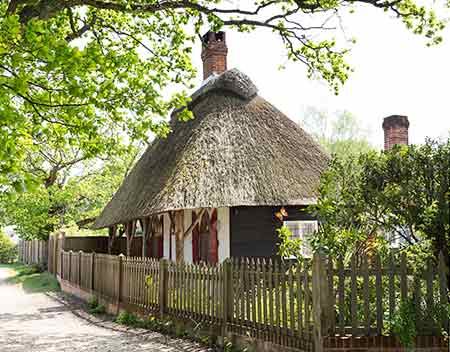
Located beside the footpath from Beaulieu, a little to the north-east of the Master Builder's, the thatched Duke's Bath House was constructed in 1760 by the Duke of Montagu for the use of his arthritic son, the Marquess of Monthermer.
It was believed that salt water would relieve the condition and a pool was therefore created in the garden, filled with Beaulieu River water.
Modern scientists, too, agree with the wise folk of old - the Daily Express under the headline 'Salt baths ease the pain of arthritis, say experts' reported in 2012: 'The saline solution reduces painful inflammation of the joints, scientists have found. The breakthrough could revolutionise how the condition, which afflicts millions, is treated. Even ordinary table salt in high concentrations can be used and, unlike conventional drugs, there are no unpleasant side-effects'.
So, it can be assumed that the Marquess' pain was at least eased, although cold water baths in Beaulieu River water were maybe not too much fun.
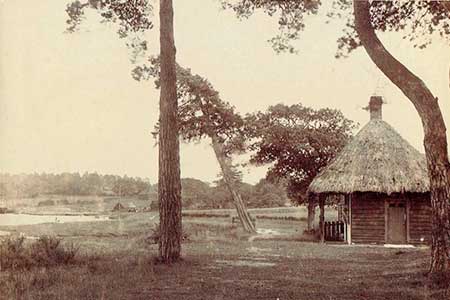
After the death of the Marquess, the house was lived in by Beaulieu Estate workers and their families until 1908 after which it was let as a weekend cottage before in 1971 being used as a yachtsmen's clubhouse. It is now once more a residence.
Find out more about Buckler's Hard's fascinating history
References:
Bucklers Hard - a rural shipbuilding centre: A.J. Holland
An Album of Old Beaulieu: Susan Tomkins
Hampshire Place Names: Richard Coates
Historic England - Buckler's Hard
Beaulieu History Society Newsletter - Henry Adams: shipbuilder
Various Wikipedia pages
Quick links
More links
Other related links
Search this site

